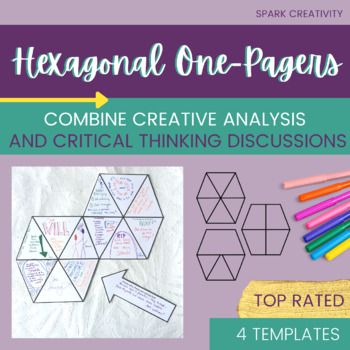Hexagonal Thinking: One Pagers l one page templates l one pager for any novel
- PDF
What educators are saying
Also included in
- One-pagers are a creative tool you can use for almost everything. All the one-pagers in this bundle have templates and specific instructions, so every student can be successful. No more staring at a blank page and wondering what the heck to put on it. Check out the video to see these one-pagers iPrice $11.50Original Price $16.85Save $5.35
Description
Hexagonal thinking is a creative way to get students making connections with one pagers. BUT, it's a lot of work for you, as the teacher, to create and cut out dozens of hexagons for your students to connect, arrange, and discuss.
Why not get the students brainstorming and designing their own hexagons with hexagonal one-pagers?
In this activity, groups of students use critical thinking, close reading, and design skills to create hexagonal one-pagers for characters, style elements, connections to the world, connections to other other works, themes and symbols.
(By the way, need a quick primer on hex thinking? Check out this video I collaborated on with Edutopia for the two minute class).
What's inside:
- Templates for large size and mini hexagonal one-pagers
- Connecting arrows students can fill in and put up
- Easy directions for one-pagers of both sizes
- Photo examples of both sizes
As the students complete and cut out their hexagons, another level of deep thinking and collaboration begin. Students work together to connect the cards on the floor, adding in connection arrows that explain why they made certain key connections. As they finalize their design, students begin to move the final product to the wall, ending up with a beautiful display representing their own critical thinking.
Check out the preview video to see hexagonal thinking one-pagers in action!
From the Reviews:
"An excellent way for students to push themselves to think further. Kids worked well together to find more ideas and realized they could get much more out of their discussions. "
"...I used this with adult learners to help them connect the big ideas of a standard we were analyzing. It worked well and forced the teachers to really think about how standards are connected. "
"I love this resource!!!!!! It creates collaboration, but can also be used independently."
Looking for more hexagonal thinking resources? Find them all here.
Questions? I'm at betsy@nowsparkcreativity.com.






